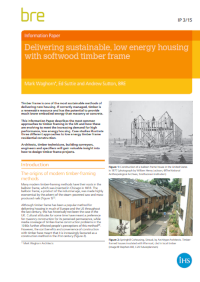Delivering sustainable low energy housing with softwood timber frame
BRE (Building Research Establishment) is an independent, research-based consultancy, testing and training organisation, operating in the built environment and associated industries.
Delivering sustainable low energy housing with softwood timber frame (IP3/15) was written by Mark Waghorn, Ed Suttie and Andrew Sutton and published by BRE on 13 January 2015.
Although timber frame has been a popular method for delivering housing in much of Europe and the US throughout the last century, this has historically not been the case in the UK. Cultural attitudes have resulted in a preference for masonry construction for its perceived permanence, and media coverage of timber-frame construction problems in the 1980s further affected people’s perceptions of this method. However, the cost benefits and convenience of construction with timber have meant it is increasingly favoured as a construction method in the 21st century.
Building with timber frame is one of the most sustainable methods of delivering new housing. If it is correctly managed, timber can be a renewable resource with lower embodied energy than masonry or concrete.
This 12-page information paper describes common approaches to timber framing in the UK and how these are evolving to meet the increasing demand for high performance, low energy housing. Case studies are also provided illustrating three approaches to low energy timber-frame residential construction.
The contents of the information paper are:
- Introduction.
- Description of the most common timber frame methods today.
- Adapting today’s methods for low energy standards.
- Issues relating to sourcing and processing timber.
- Conclusions.
- References and notes, and further reading.
[edit] Find out more.
[edit] Related articles on Designing Buildings Wiki
- A guide to the use of urban timber FB 50.
- Balloon framing.
- BRE articles on Designing Buildings Wiki.
- BRE Buzz articles on Designing Buildings Wiki.
- BRE Buzz.
- BREEAM.
- Building Research Establishment.
- Embodied energy.
- Sustainable materials.
- Sustainable timber.
- Timber frame.
- Timber framed buildings and fire.
- Types of timber.
Featured articles and news
RTPI leader to become new CIOB Chief Executive Officer
Dr Victoria Hills MRTPI, FICE to take over after Caroline Gumble’s departure.
Social and affordable housing, a long term plan for delivery
The “Delivering a Decade of Renewal for Social and Affordable Housing” strategy sets out future path.
A change to adoptive architecture
Effects of global weather warming on architectural detailing, material choice and human interaction.
The proposed publicly owned and backed subsidiary of Homes England, to facilitate new homes.
How big is the problem and what can we do to mitigate the effects?
Overheating guidance and tools for building designers
A number of cool guides to help with the heat.
The UK's Modern Industrial Strategy: A 10 year plan
Previous consultation criticism, current key elements and general support with some persisting reservations.
Building Safety Regulator reforms
New roles, new staff and a new fast track service pave the way for a single construction regulator.
Architectural Technologist CPDs and Communications
CIAT CPD… and how you can do it!
Cooling centres and cool spaces
Managing extreme heat in cities by directing the public to places for heat stress relief and water sources.
Winter gardens: A brief history and warm variations
Extending the season with glass in different forms and terms.
Restoring Great Yarmouth's Winter Gardens
Transforming one of the least sustainable constructions imaginable.
Construction Skills Mission Board launch sector drive
Newly formed government and industry collaboration set strategy for recruiting an additional 100,000 construction workers a year.
New Architects Code comes into effect in September 2025
ARB Architects Code of Conduct and Practice available with ongoing consultation regarding guidance.
Welsh Skills Body (Medr) launches ambitious plan
The new skills body brings together funding and regulation of tertiary education and research for the devolved nation.
Paul Gandy FCIOB announced as next CIOB President
Former Tilbury Douglas CEO takes helm.
UK Infrastructure: A 10 Year Strategy. In brief with reactions
With the National Infrastructure and Service Transformation Authority (NISTA).
























